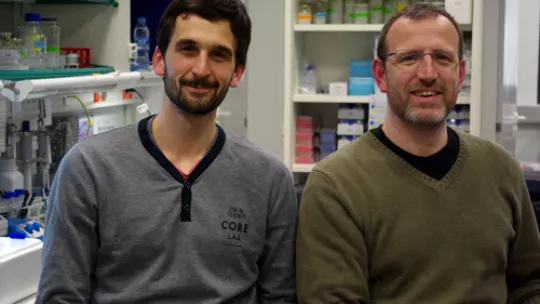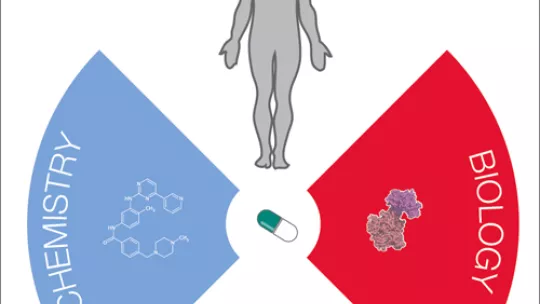Images
• This is the first study that studies and quantifies 1,600 known adverse effects of drugs currently on the market.
• The scientists Miquel Duran and Patrick Aloy provide a description of the molecular processes responsible for more than 1,000 secondary effects.
• This knowledge, which is available to the scientific community, may be of great use to minimize and predict adverse effects during drug design.
Yellow vision, pseudo-pulmonary obstruction, involuntary body movements, respiratory paralysis. These are some of the 1,600 known side effects (SEs) produced by drugs. Adverse effects are one of the main causes of hospital admission in the west. These effects are difficult to predict, and in practice specific assays are required to test the safety of agents in pre-clinical phases, thus these effects are often not discovered until the drug has been launched. A study published by scientists at the Institute for Research in Biomedicine (IRB Barcelona) seeks to fill this information gap. The objective of the study is to shed light on the molecular bases of SEs and provide medical chemists with the tools to design safer drugs and to predict their effects. The study collects and proposes molecular hypotheses for 1,162 side effects. This information, which is about to be tested experimentally, is now available to the scientific community through the most recent issue of the specialized journal Chemistry and Biology, part of the Cell group.
The researchers Miquel Duran and Patrick Aloy collated all the drugs that cause each known SE. Next, they studied the proteins with which they interact and their chemical structure. “For most of the side effects we have a biological hypothesis, and for many of these cases we also have chemical information about the drug, which may be useful to predict a specific secondary effect,” explains ICREA researcher Patrick Aloy, head of the “Structural Bioinformatics and Network Biology” at IRB Barcelona. Of the 1,162 SEs for which they have found a molecular description, 446 can be explained solely on the basis of biology and 68 only on the basis of chemistry, while for 648 (56%) both biological and chemical considerations are required.
Some examples: xanthopsia and buccoglossal syndrome
One of the SEs described is buccoglossal syndrome, a disorder involving involuntary movements of the body and caused by six different drugs. The researchers propose that drugs whose structures include a piperazine ring and, in addition, interact with the receptors 5-HT2A and/or DRD2 are more likely to cause this syndrome. “This is one of the examples where we need a biological and chemical explanation,” says Miquel Duran, a chemist doing his PhD in Aloy’s lab, and first author of the paper. “Another interesting case is xanthopsia, a predominance of yellow in the vision, a condition supposedly experienced by Van Gogh”, explain the researchers. “In this case we do not suspect any related protein but observe that there are chemical structures that can cause this disorder, which we have annotated in 13 drugs that include this condition as a possible side effect” .
“We are providing the scientific community with lists of proteins and the chemical features associated with SEs. We refer to these as “alerts”: they can be used by drug design experts to try to avoid certain interactions and/or structures in order to develop safer drugs,” says Aloy.
For these scientists, it is necessary to combine biology and chemistry in order to determine what may be causing a given SE. “In practice, and for each unwanted effect, there is a biological part that we know, but this part does not offer a complete picture of the mechanism and perhaps we will be able to fill this gap by “looking at” the chemical structure,” upholds Duran. “The multidisciplinarity provided by IRB Barcelona allows us to start studies with these characteristics, which require the convergence of several fields to achieve a more complete understanding,” says Dr. Aloy, an expert in systems biology.
Reference article:
Analysis of Chemical and Biological Features Yields Mechanistic Insights into Drug Side Effects
Miquel Duran-Frigola and Patrick Aloy
Chemistry and Biology (2013): http://dx.doi.org/10.1016/j.chembiol.2013.03.017
About IRB Barcelona
The Institute for Research in Biomedicine (IRB Barcelona) pursues a society free of disease. To this end, it conducts multidisciplinary research of excellence to cure cancer and other diseases linked to ageing. It establishes technology transfer agreements with the pharmaceutical industry and major hospitals to bring research results closer to society, and organises a range of science outreach activities to engage the public in an open dialogue. IRB Barcelona is an international centre that hosts 400 researchers and more than 30 nationalities. Recognised as a Severo Ochoa Centre of Excellence since 2011, IRB Barcelona is a CERCA centre and member of the Barcelona Institute of Science and Technology (BIST).








